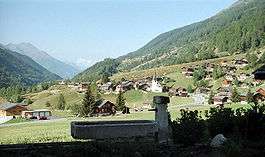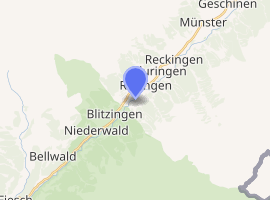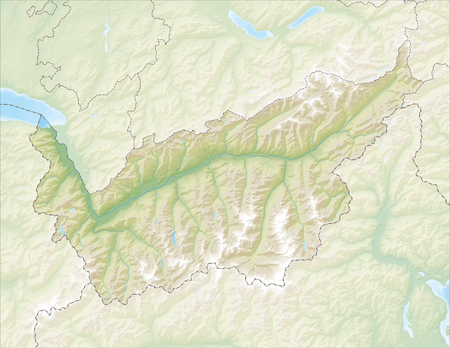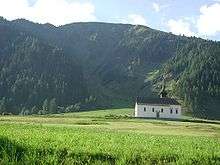Grafschaft, Switzerland
Grafschaft is a former municipality in the district of Goms in the canton of Valais in Switzerland. In 2000 the municipality was created with the merger of Biel (VS), Ritzingen and Selkingen.[2] On 1 January 2017 the former municipalities of Grafschaft, Blitzingen, Münster-Geschinen, Niederwald and Reckingen-Gluringen merged into the new municipality of Goms.
Grafschaft | |
|---|---|
 | |
 Coat of arms | |
Location of Grafschaft 
| |
 Grafschaft  Grafschaft | |
| Coordinates: 46°27′N 8°13′E | |
| Country | Switzerland |
| Canton | Valais |
| District | Goms |
| Government | |
| • Mayor | Beat Mutter |
| Area | |
| • Total | 22.6 km2 (8.7 sq mi) |
| Elevation | 1,312 m (4,304 ft) |
| Population (December 2002) | |
| • Total | 206 |
| • Density | 9.1/km2 (24/sq mi) |
| Postal code | 3989 |
| SFOS number | 6073 |
| Surrounded by | Bellwald, Blitzingen, Ernen, Fieschertal, Reckingen-Gluringen |
| Website | www SFSO statistics |
History
Grafschaft was created in 2000 through the merger of Biel (VS), Ritzingen and Selkingen.[3] Biel was first mentioned in 1277 as Buele.[4] Starting in the 13th Century, Ritzingen gradually became a municipality. By the 16th Century the traditional practices and pastures of the farmers were finally codified into laws.[5] Selkingen was first mentioned in 1374 as villa de Selgingen.[6]
Geography

Grafschaft had an area, as of 2011, of 22.6 square kilometers (8.7 sq mi). Of this area, 27.7% is used for agricultural purposes, while 20.4% is forested. Of the rest of the land, 1.6% is settled (buildings or roads) and 50.4% is unproductive land.[7]
Coat of arms
The blazon of the municipal coat of arms is Azure a Crozier Or issuiant from base surrounded with three Mullets of five of the same.[8]
Demographics
Grafschaft had a population (as of 2015) of 206. As of 2008, 7.6% of the population are resident foreign nationals.[9] Over the last 10 years (1999–2009 ) the population has changed at a rate of -4.3%. It has changed at a rate of 3.4% due to migration and at a rate of -3.4% due to births and deaths.[7]
Most of the population (as of 2000) speaks German (186 or 96.9%) as their first language, Serbo-Croatian is the second most common (4 or 2.1%) and French is the third (1 or 0.5%).[10]
As of 2008, the gender distribution of the population was 47.7% male and 52.3% female. The population was made up of 90 Swiss men (45.2% of the population) and 5 (2.5%) non-Swiss men. There were 93 Swiss women (46.7%) and 11 (5.5%) non-Swiss women.[11] Of the population in the municipality 109 or about 56.8% were born in Grafschaft and lived there in 2000. There were 53 or 27.6% who were born in the same canton, while 15 or 7.8% were born somewhere else in Switzerland, and 10 or 5.2% were born outside of Switzerland.[10]
The age distribution of the population (as of 2000) is children and teenagers (0–19 years old) make up 22.4% of the population, while adults (20–64 years old) make up 54.7% and seniors (over 64 years old) make up 22.9%.[7]
As of 2000, there were 73 people who were single and never married in the municipality. There were 102 married individuals, 13 widows or widowers and 4 individuals who are divorced.[10]
As of 2000, there were 69 private households in the municipality, and an average of 2.3 persons per household.[7] There were 24 households that consist of only one person and 3 households with five or more people. Out of a total of 70 households that answered this question, 34.3% were households made up of just one person and there was 1 adult who lived with their parents. Of the rest of the households, there are 15 married couples without children, 24 married couples with children There were 4 single parents with a child or children. There was 1 household that was made up of unrelated people and 1 household that was made up of some sort of institution or another collective housing.[10]
In 2000 there were 72 single family homes (or 45.0% of the total) out of a total of 160 inhabited buildings. There were 73 multi-family buildings (45.6%), along with 8 multi-purpose buildings that were mostly used for housing (5.0%) and 7 other use buildings (commercial or industrial) that also had some housing (4.4%).[12]
In 2000, a total of 69 apartments (23.5% of the total) were permanently occupied, while 191 apartments (65.2%) were seasonally occupied and 33 apartments (11.3%) were empty.[12]
The historical population is given in the following chart:[13]

Sights
The entire villages of Biel, Ritzingen and Selkingen are designated as part of the Inventory of Swiss Heritage Sites[14]
Politics
In the 2007 federal election the most popular party was the CVP which received 58.79% of the vote. The next three most popular parties were the SP (18.94%), the SVP (18.18%) and the FDP (3.03%). In the federal election, a total of 97 votes were cast, and the voter turnout was 54.8%.[15]
In the 2009 Conseil d'Etat/Staatsrat election a total of 90 votes were cast, of which 9 or about 10.0% were invalid. The voter participation was 53.6%, which is similar to the cantonal average of 54.67%.[16] In the 2007 Swiss Council of States election a total of 97 votes were cast, of which 2 or about 2.1% were invalid. The voter participation was 54.8%, which is much less than the cantonal average of 59.88%.[17]
Economy
As of 2010, Grafschaft had an unemployment rate of 1.3%. As of 2008, there were 19 people employed in the primary economic sector and about 8 businesses involved in this sector. 3 people were employed in the secondary sector and there were 2 businesses in this sector. 32 people were employed in the tertiary sector, with 9 businesses in this sector.[7] There were 90 residents of the municipality who were employed in some capacity, of which females made up 44.4% of the workforce.
In 2008 the total number of full-time equivalent jobs was 40. The number of jobs in the primary sector was 16, of which 10 were in agriculture and 6 were in forestry or lumber production. The number of jobs in the secondary sector was 3 of which 2 or (66.7%) were in manufacturing and 1 was in construction. The number of jobs in the tertiary sector was 21. In the tertiary sector; 2 or 9.5% were in wholesale or retail sales or the repair of motor vehicles, 2 or 9.5% were in the movement and storage of goods, 12 or 57.1% were in a hotel or restaurant, 1 was the insurance or financial industry, 1 was a technical professional or scientist, .[18]
In 2000, there were 31 workers who commuted into the municipality and 50 workers who commuted away. The municipality is a net exporter of workers, with about 1.6 workers leaving the municipality for every one entering.[19] Of the working population, 16.7% used public transportation to get to work, and 51.1% used a private car.[7]
Religion
From the 2000 census, 178 or 92.7% were Roman Catholic, while 10 or 5.2% belonged to the Swiss Reformed Church. Of the rest of the population, there were 2 members of an Orthodox church (or about 1.04% of the population).[10]
Education
In Grafschaft about 77 or (40.1%) of the population have completed non-mandatory upper secondary education, and 8 or (4.2%) have completed additional higher education (either university or a Fachhochschule). Of the 8 who completed tertiary schooling, 87.5% were Swiss men, 0.0% were Swiss women.[10]
As of 2000, there were 13 students in Grafschaft who came from another municipality, while 20 residents attended schools outside the municipality.[19]
References
- "Arealstatistik Standard - Gemeinden nach 4 Hauptbereichen". Federal Statistical Office. Retrieved 13 January 2019.
- Amtliches Gemeindeverzeichnis der Schweiz published by the Swiss Federal Statistical Office (in German) accessed 19 July 2011
- Grafschaft in German, French and Italian in the online Historical Dictionary of Switzerland.
- Biel (VS) in German, French and Italian in the online Historical Dictionary of Switzerland.
- Ritzingen in German, French and Italian in the online Historical Dictionary of Switzerland.
- Selkingen in German, French and Italian in the online Historical Dictionary of Switzerland.
- Swiss Federal Statistical Office Archived 5 January 2016 at the Wayback Machine accessed 7 September 2011
- Flags of the World.com accessed 7 September 2011
- Swiss Federal Statistical Office - Superweb database - Gemeinde Statistics 1981-2008 Archived 28 June 2010 at the Wayback Machine (in German) accessed 19 June 2010
- STAT-TAB Datenwürfel für Thema 40.3 - 2000 Archived 9 April 2014 at the Wayback Machine (in German) accessed 2 February 2011
- Ständige Wohnbevolkerung nach Geschlecht und Heimat am 31.12.2009.xls (in German and French) accessed 24 August 2011
- Swiss Federal Statistical Office STAT-TAB - Datenwürfel für Thema 09.2 - Gebäude und Wohnungen Archived 7 September 2014 at the Wayback Machine (in German) accessed 28 January 2011
- Swiss Federal Statistical Office STAT-TAB Bevölkerungsentwicklung nach Region, 1850-2000 Archived 30 September 2014 at the Wayback Machine (in German) accessed 29 January 2011
- "Kantonsliste A-Objekte". KGS Inventar (in German). Federal Office of Civil Protection. 2009. Archived from the original on 28 June 2010. Retrieved 25 April 2011.
- Swiss Federal Statistical Office, Nationalratswahlen 2007: Stärke der Parteien und Wahlbeteiligung, nach Gemeinden/Bezirk/Canton Archived 14 May 2015 at the Wayback Machine (in German) accessed 28 May 2010
- Staatsratswahlen vom 1. März 2009 (in German) accessed 24 August 2011
- Ständeratswahl 2007 (in German) accessed 24 August 2011
- Swiss Federal Statistical Office STAT-TAB Betriebszählung: Arbeitsstätten nach Gemeinde und NOGA 2008 (Abschnitte), Sektoren 1-3 Archived 25 December 2014 at the Wayback Machine (in German) accessed 28 January 2011
- Swiss Federal Statistical Office - Statweb (in German) accessed 24 June 2010
External links
| Wikimedia Commons has media related to Grafschaft. |
- Official website (in German)
- Grafschaft in German, French and Italian in the online Historical Dictionary of Switzerland.